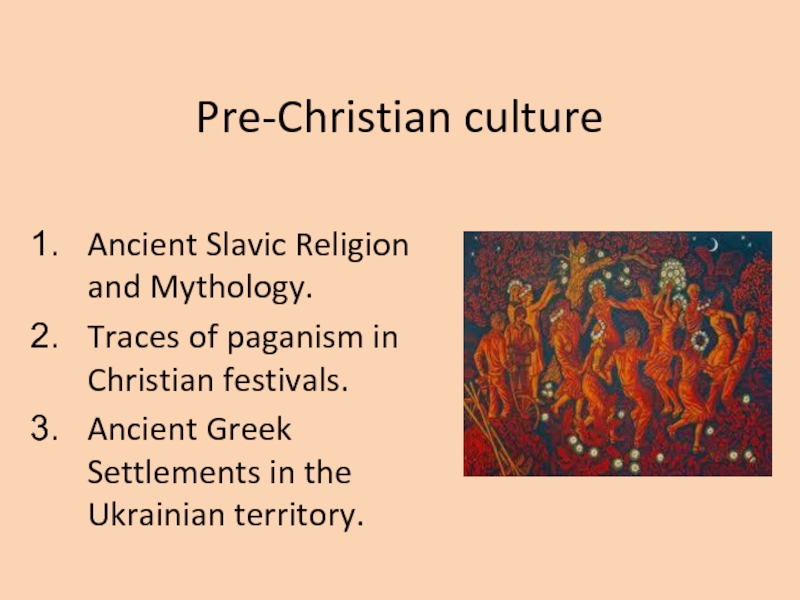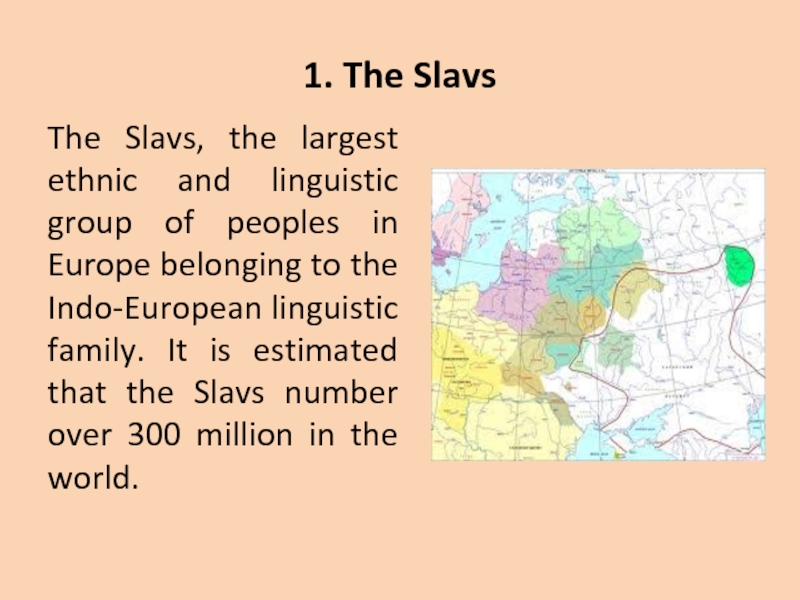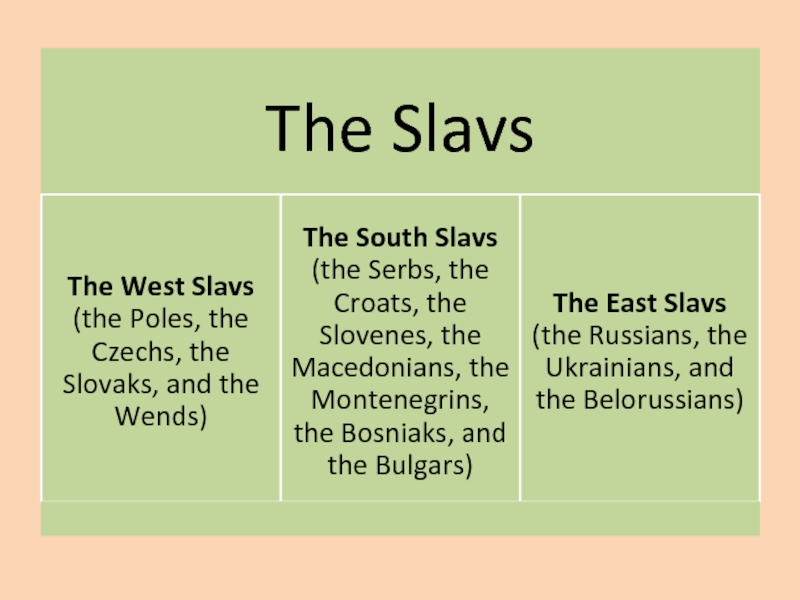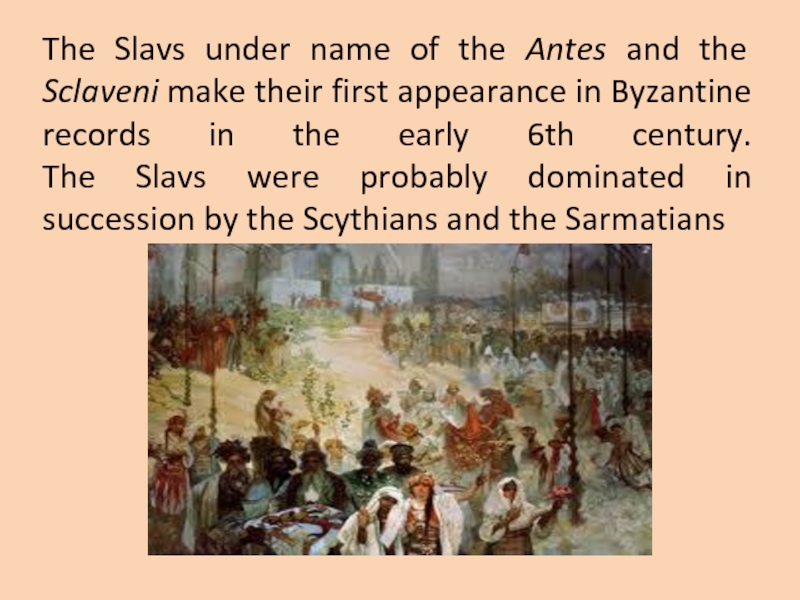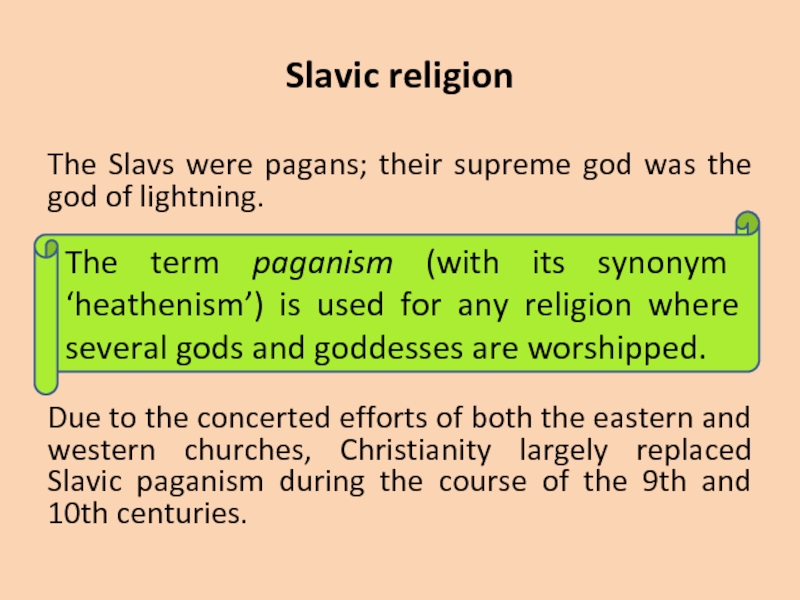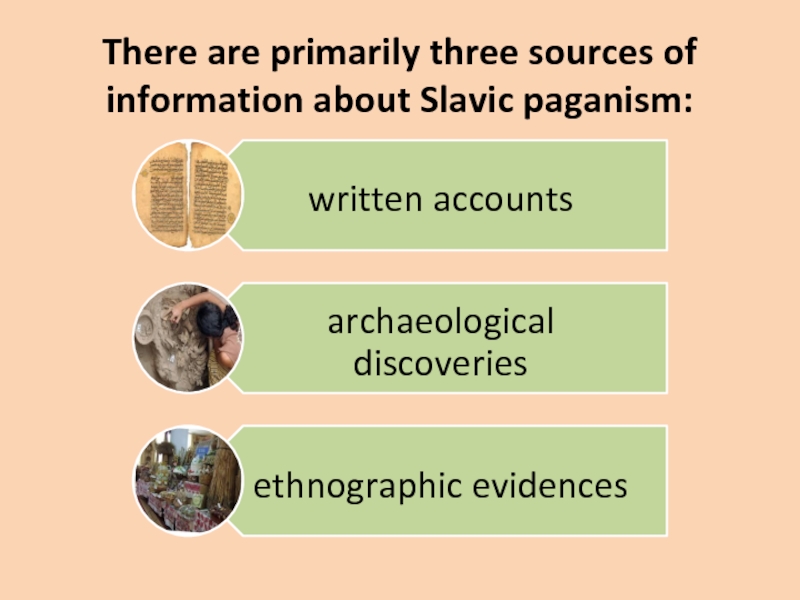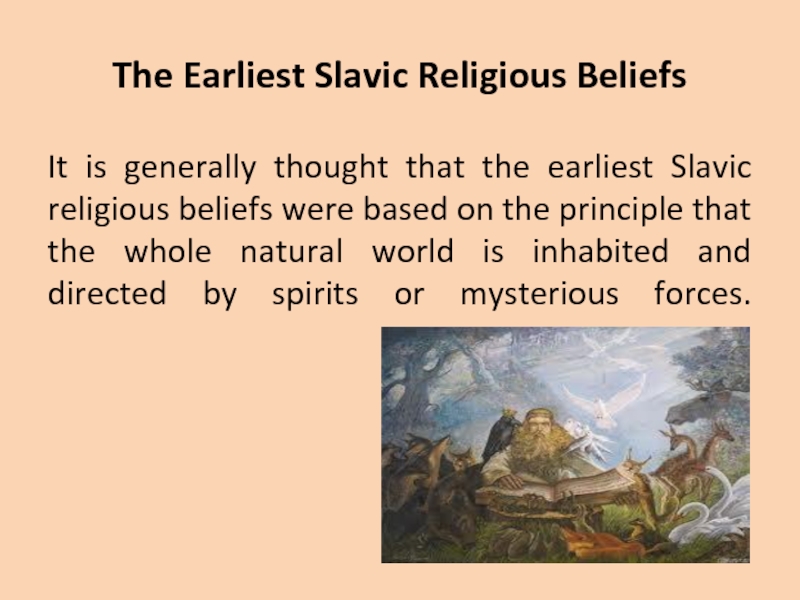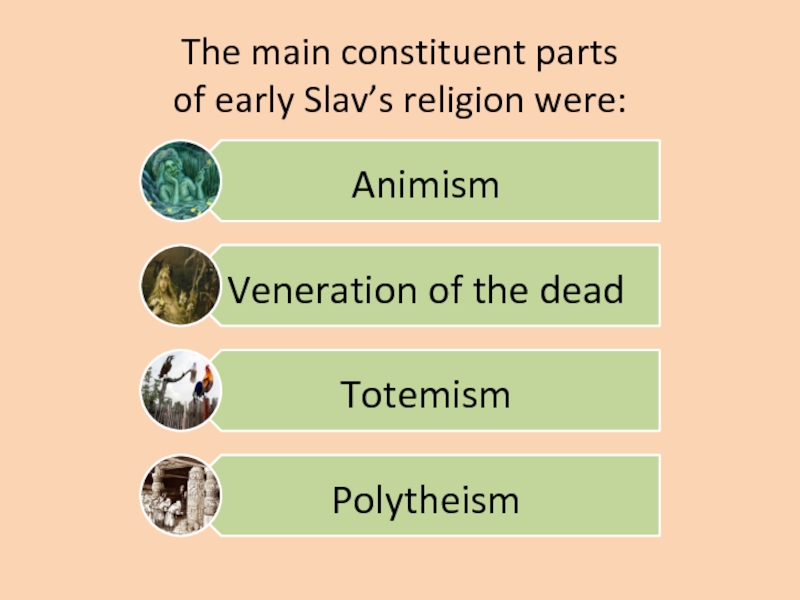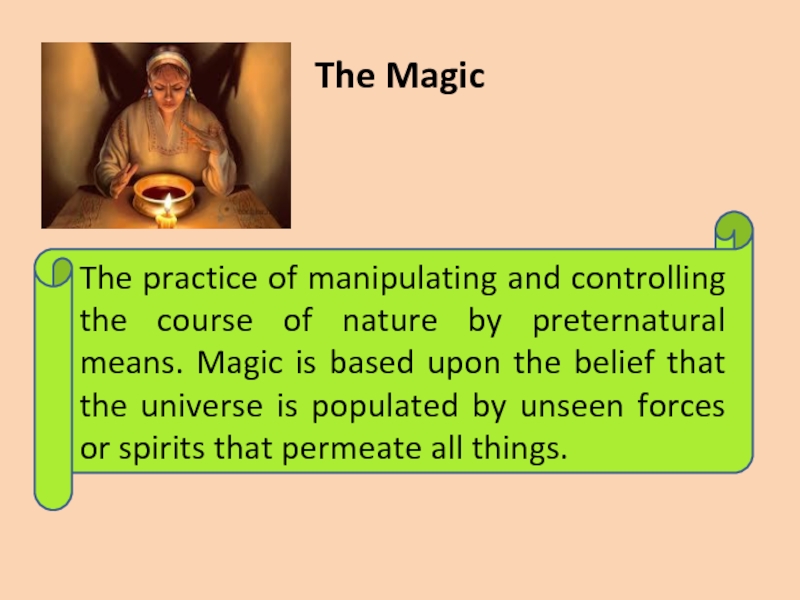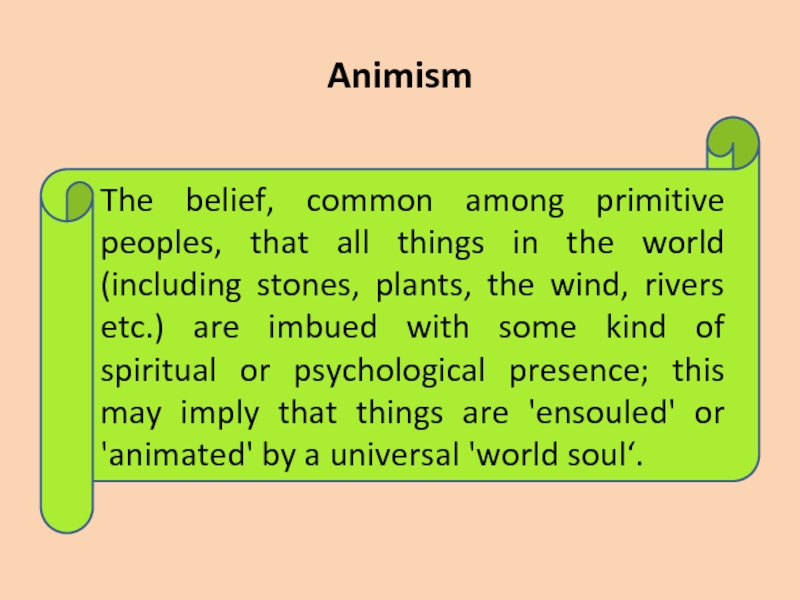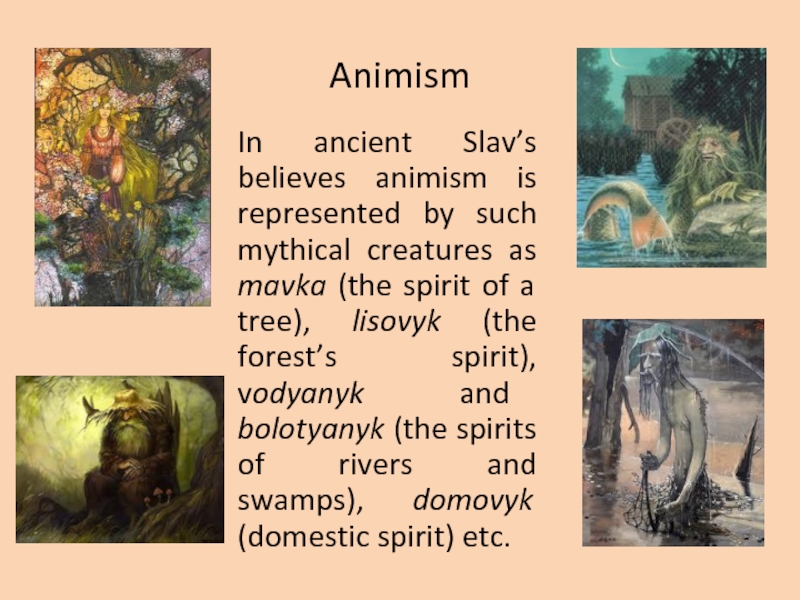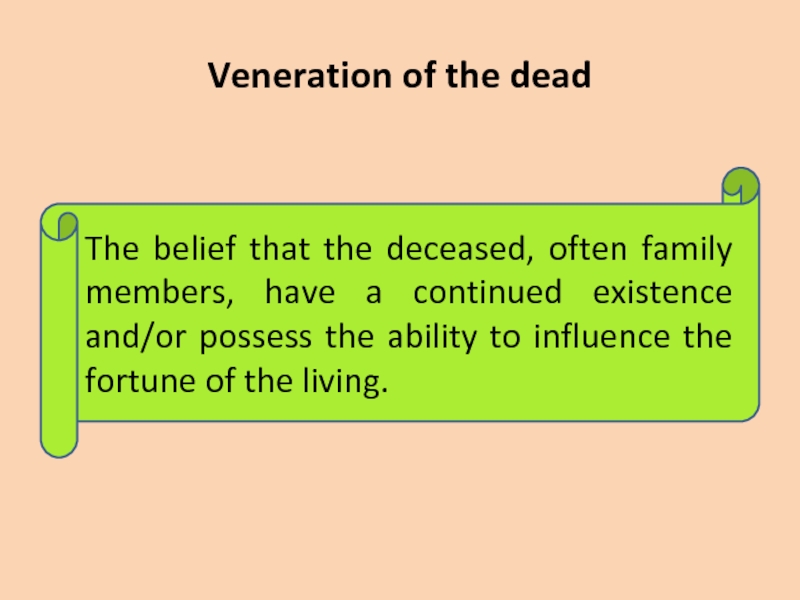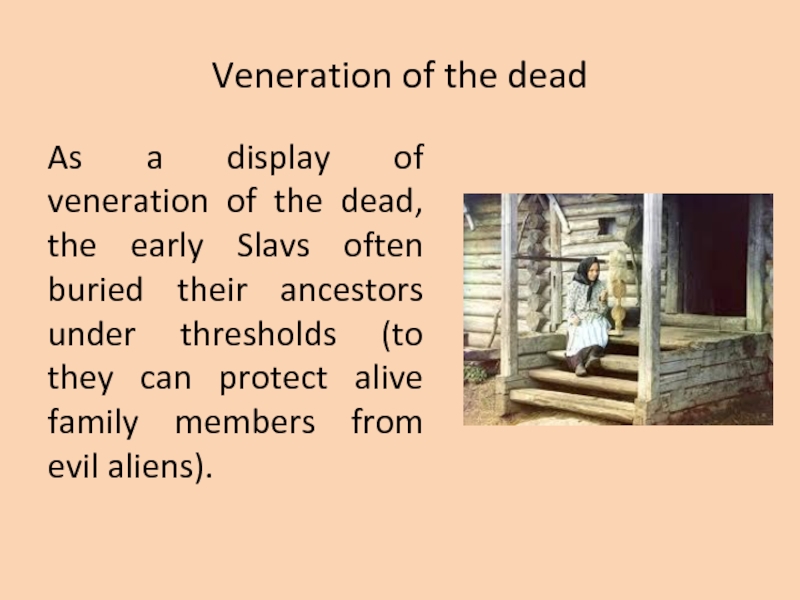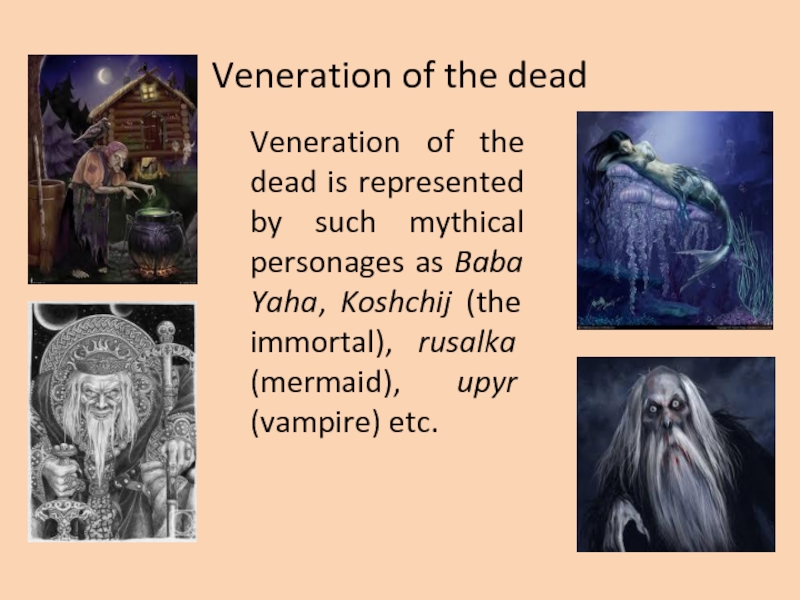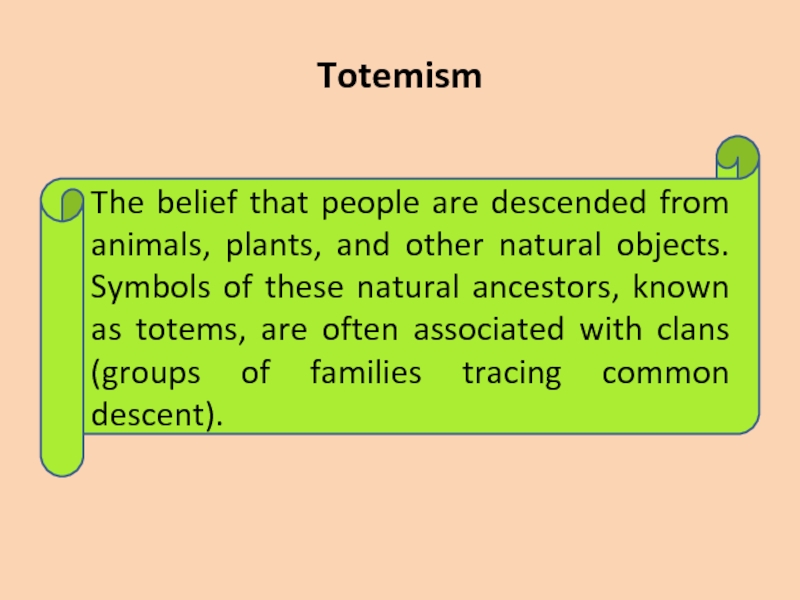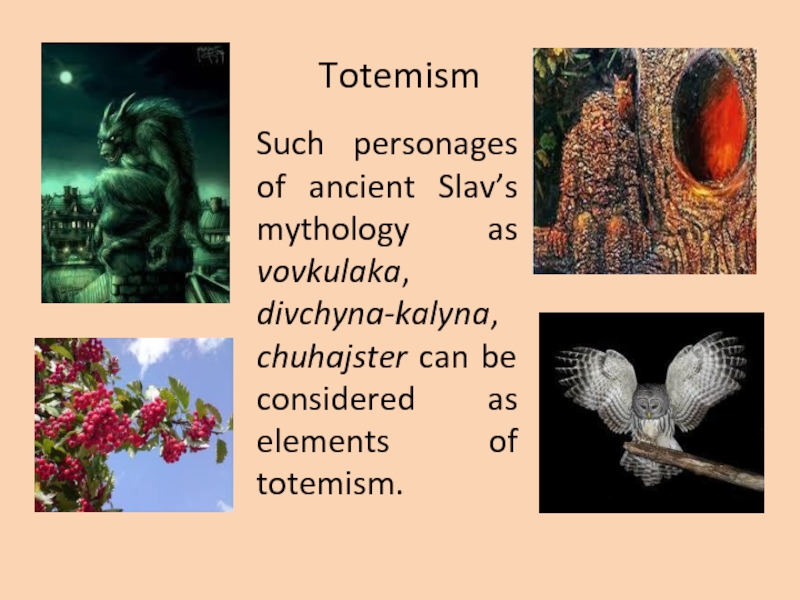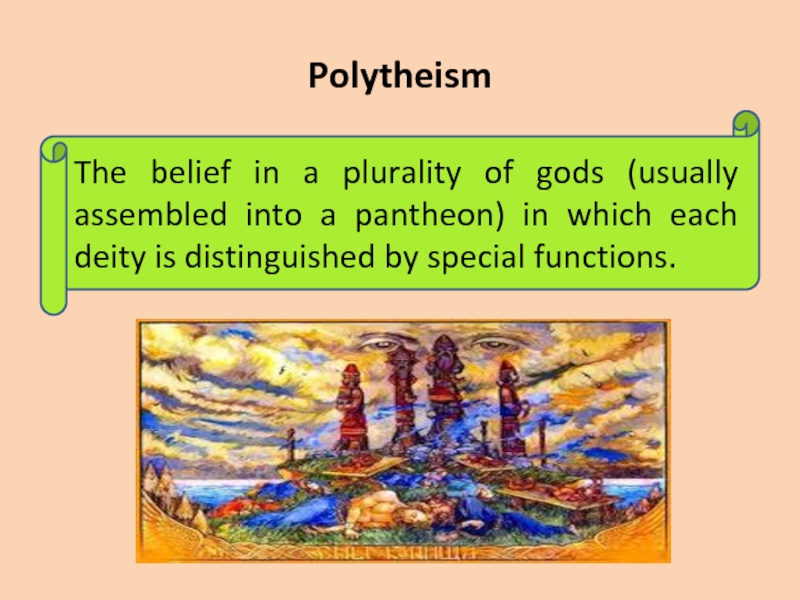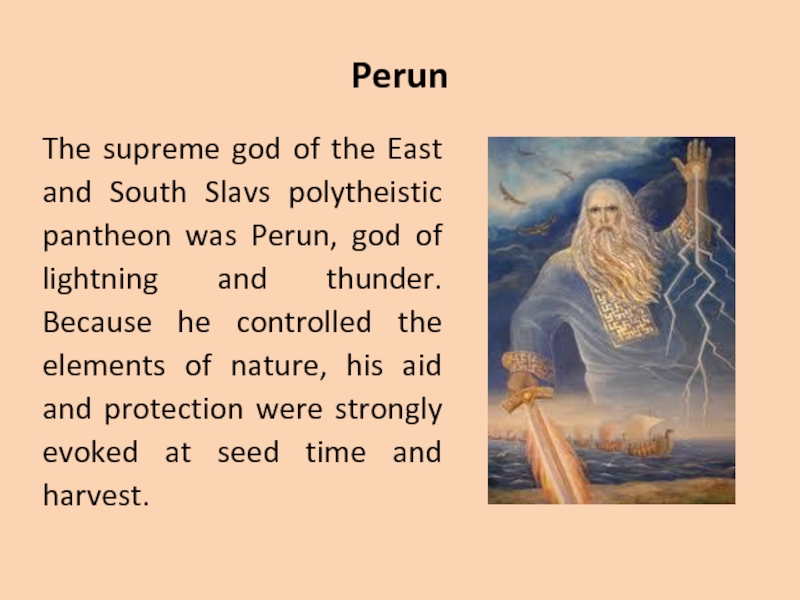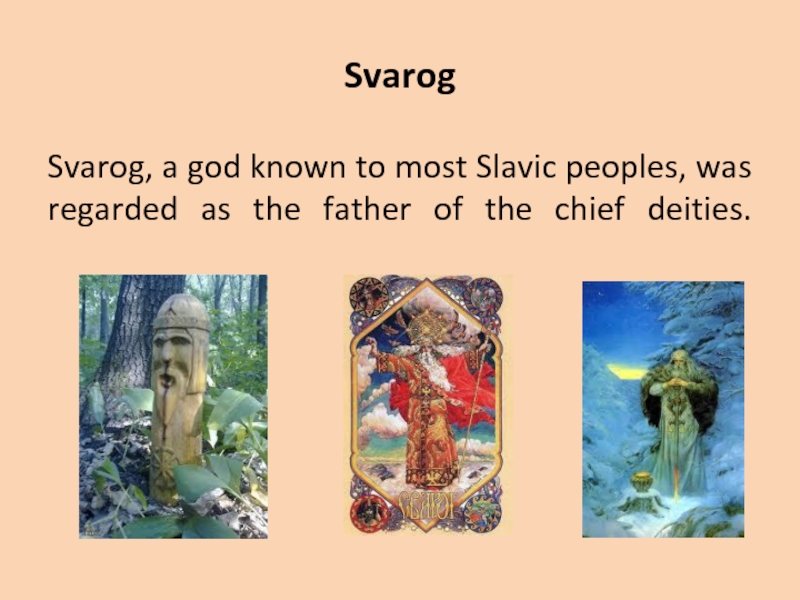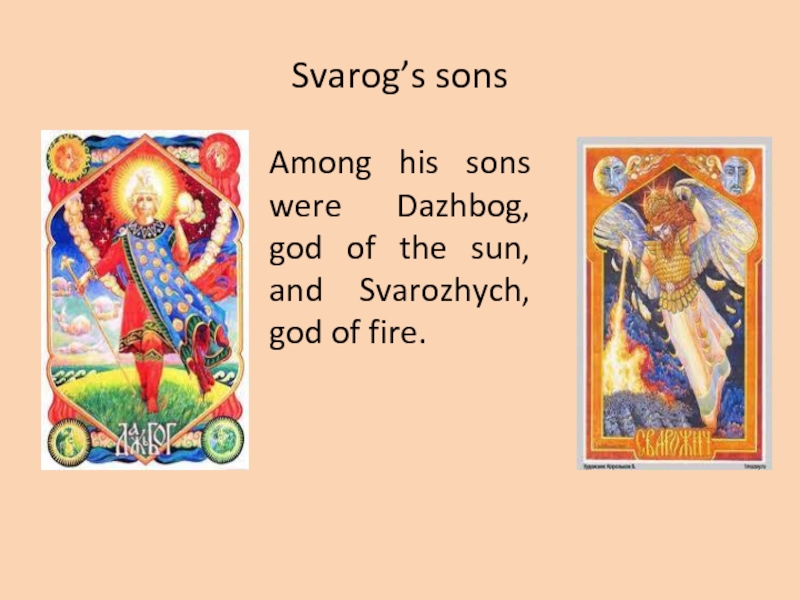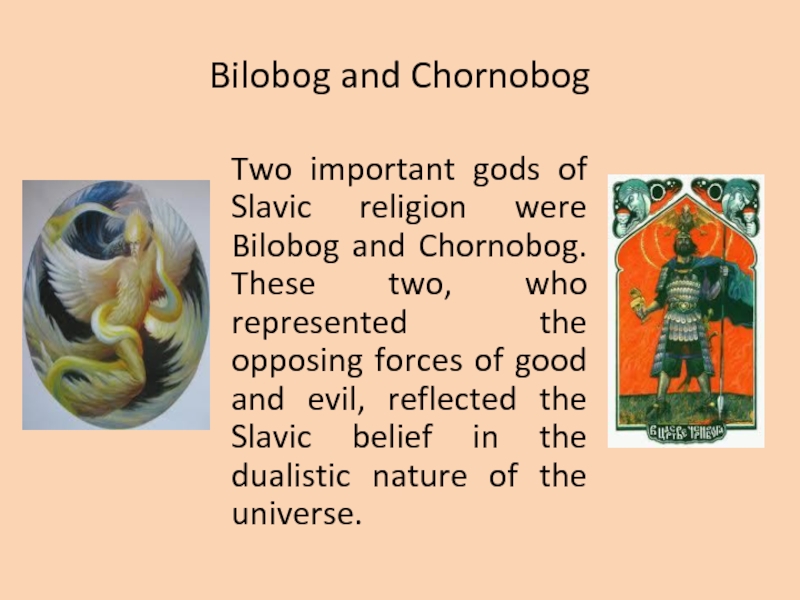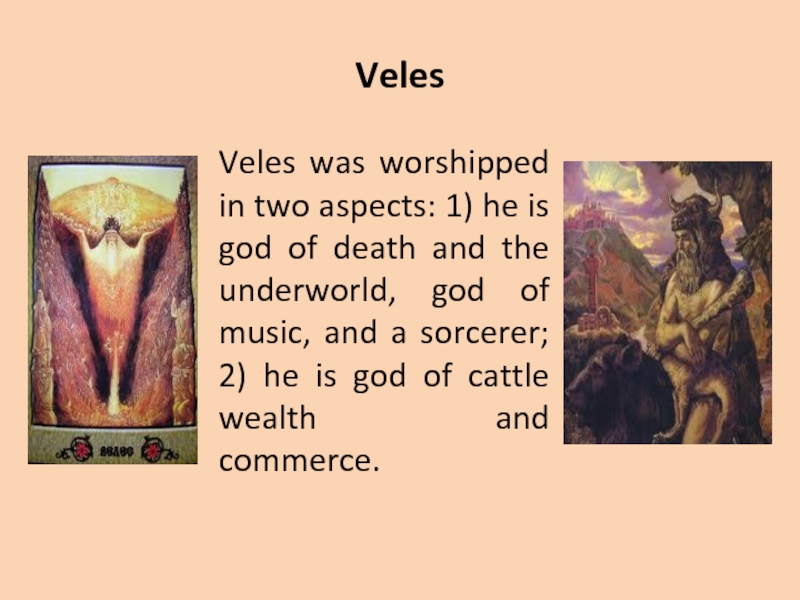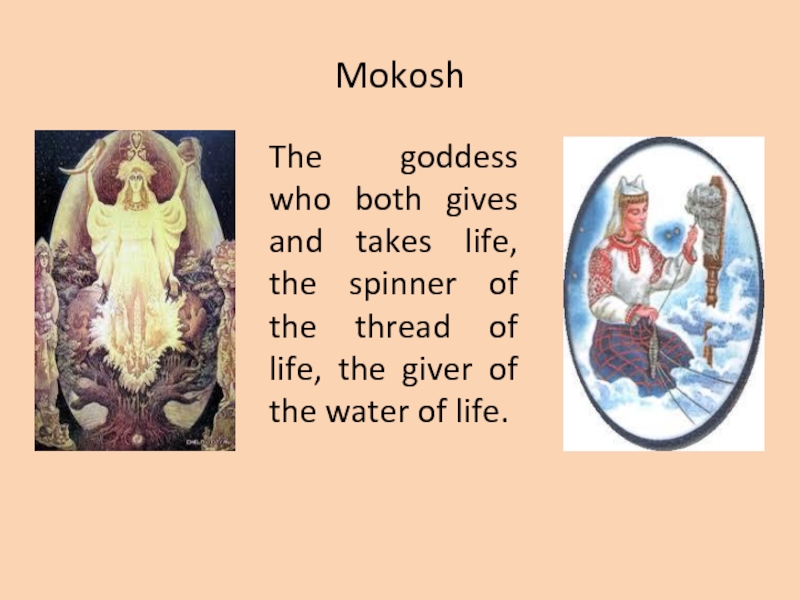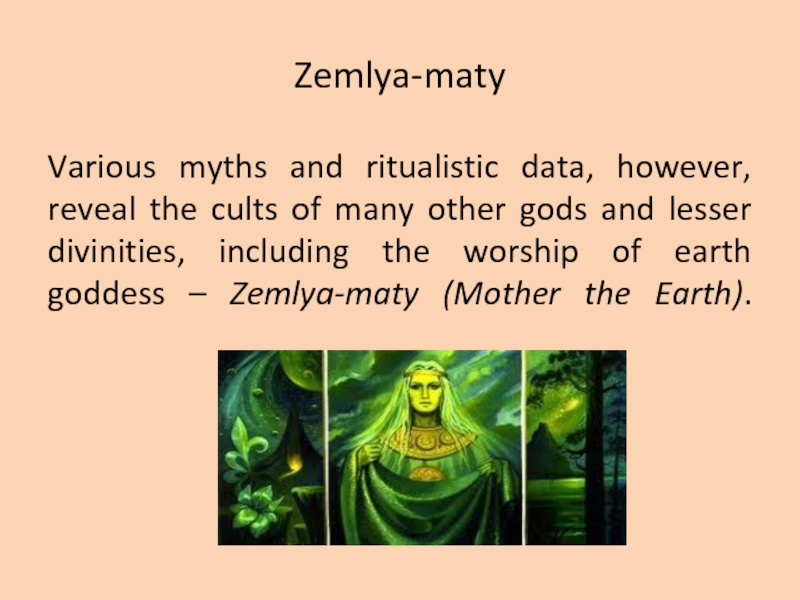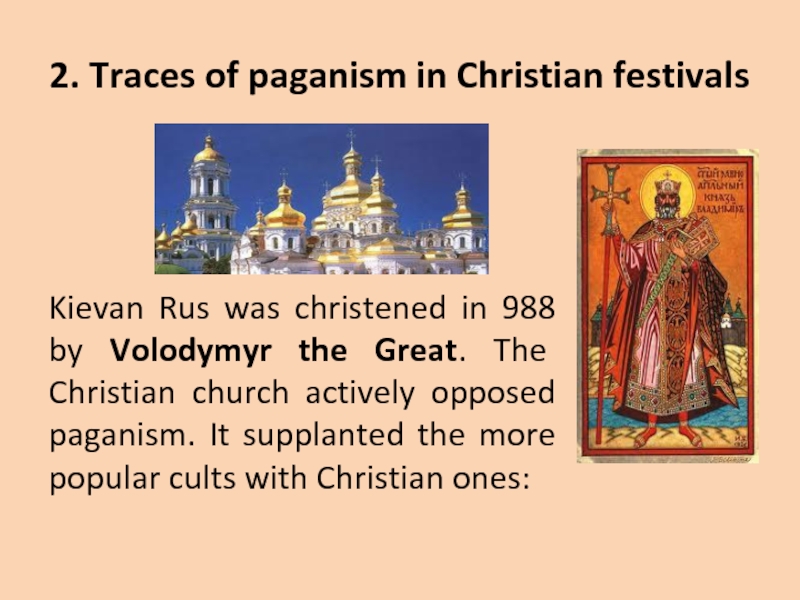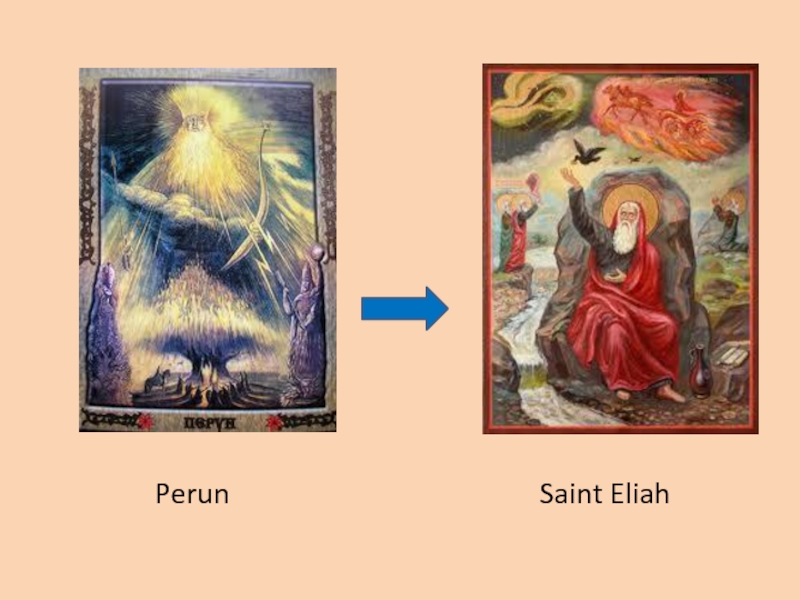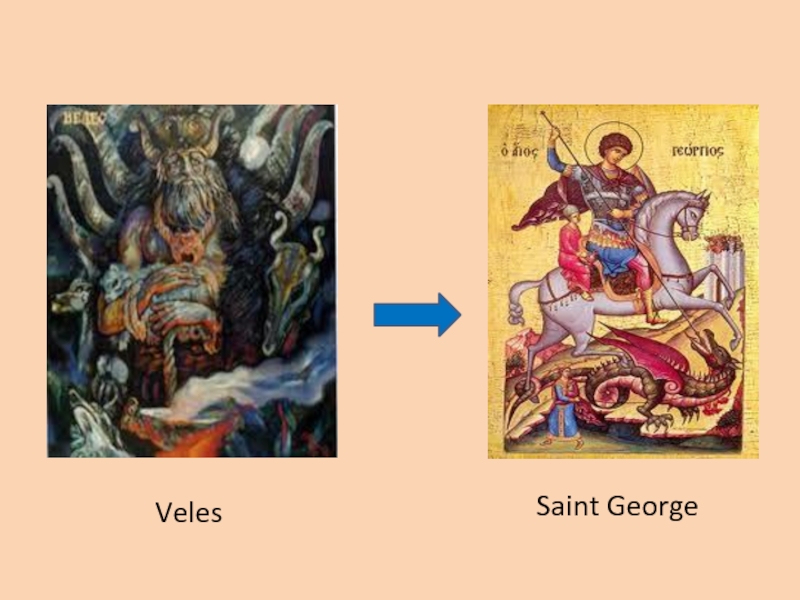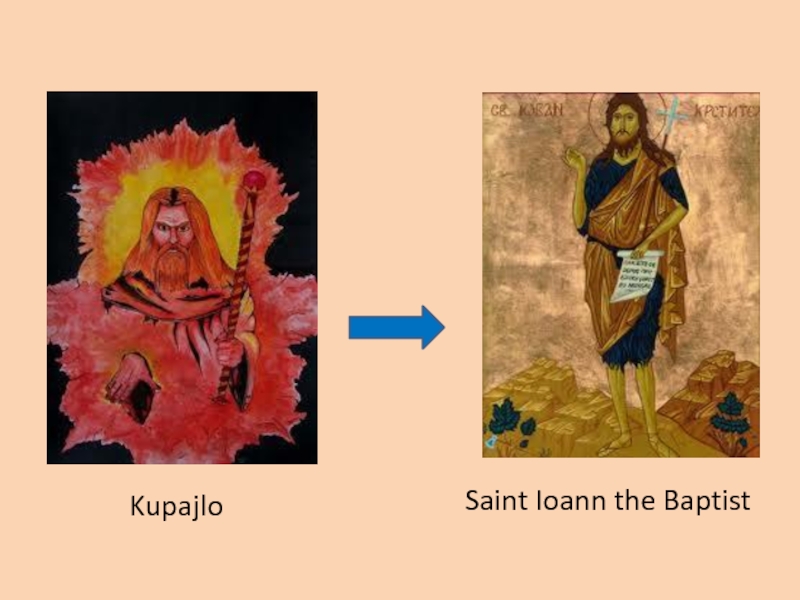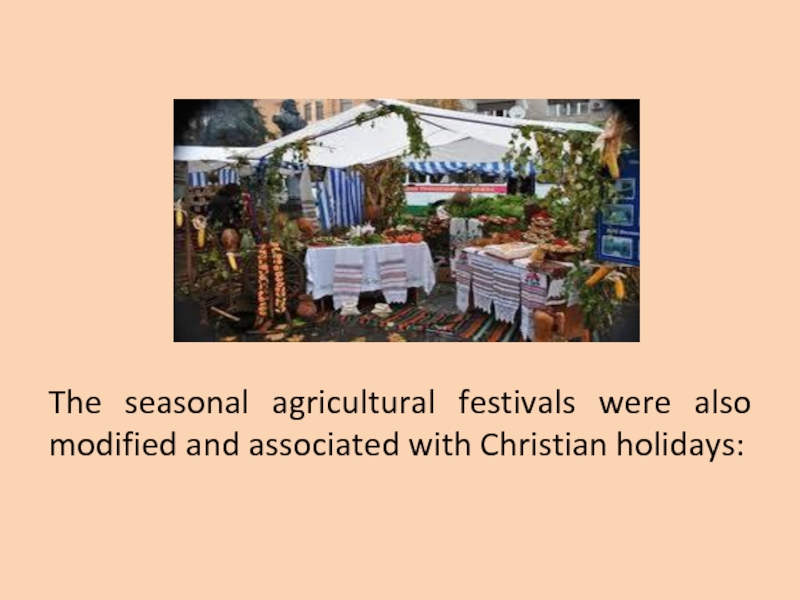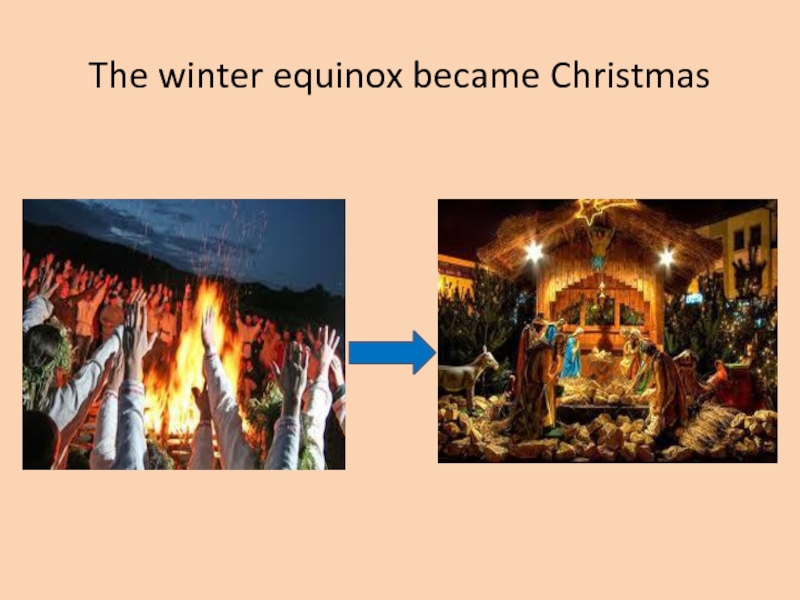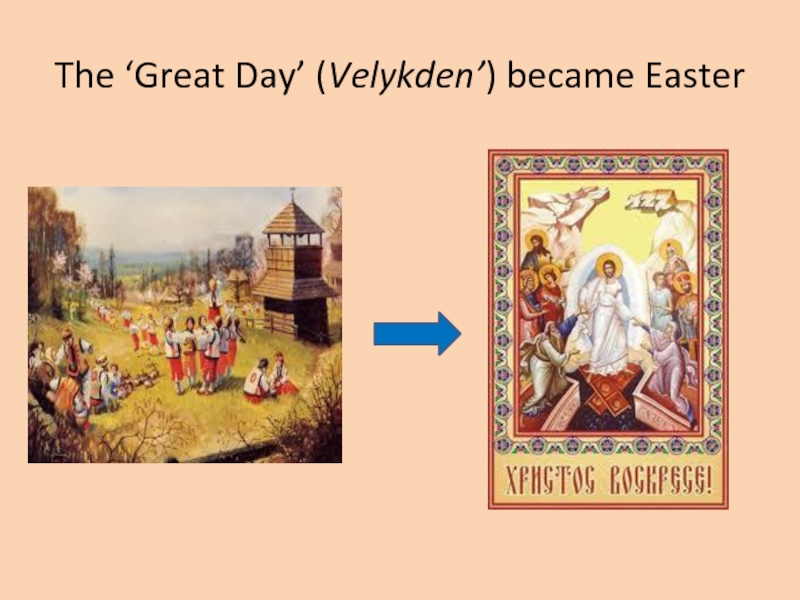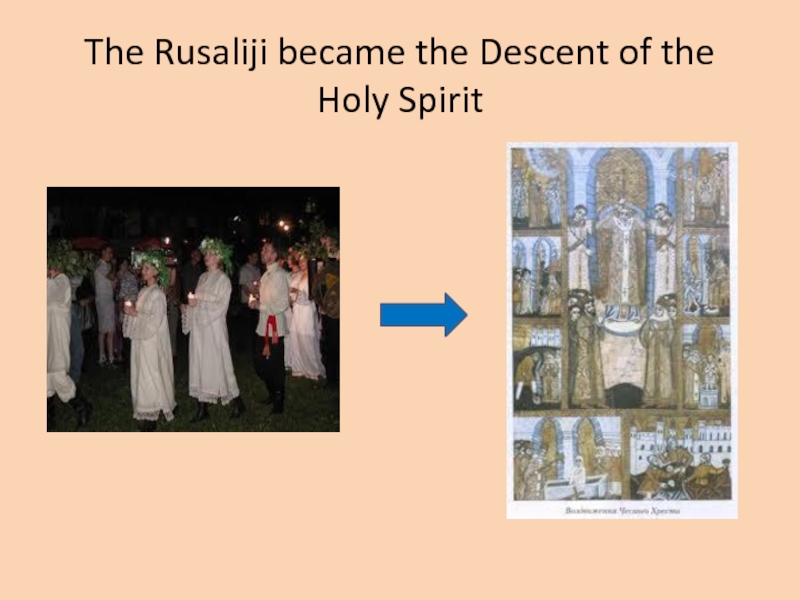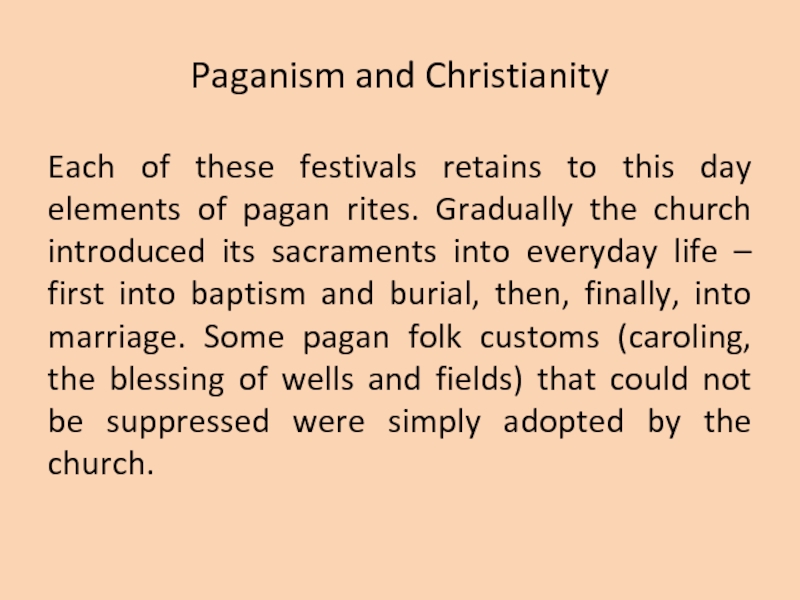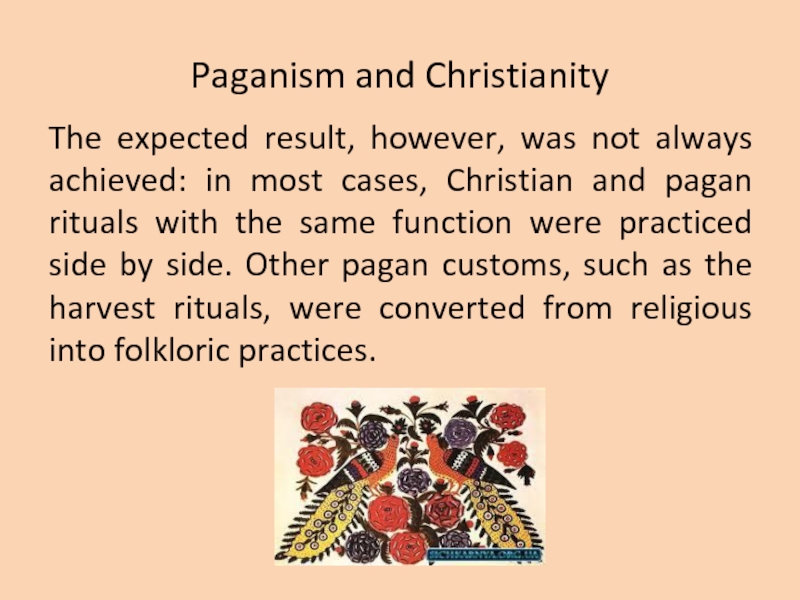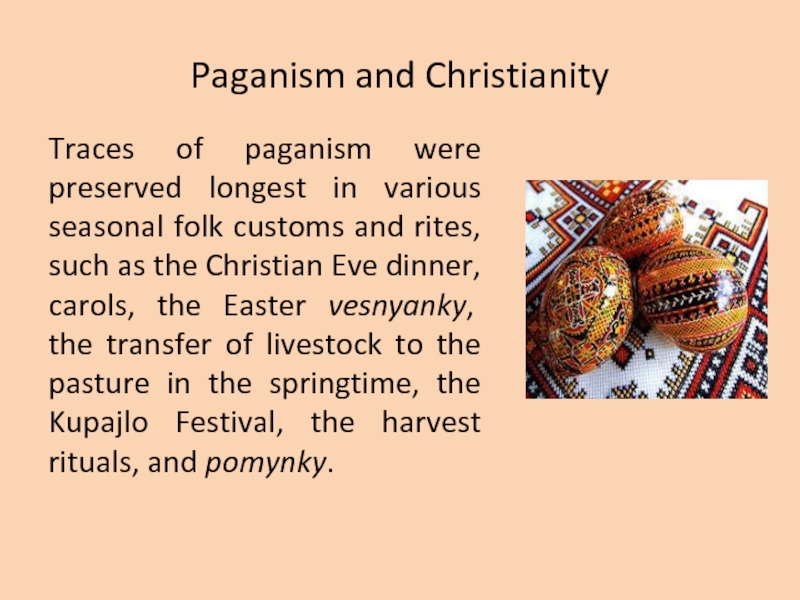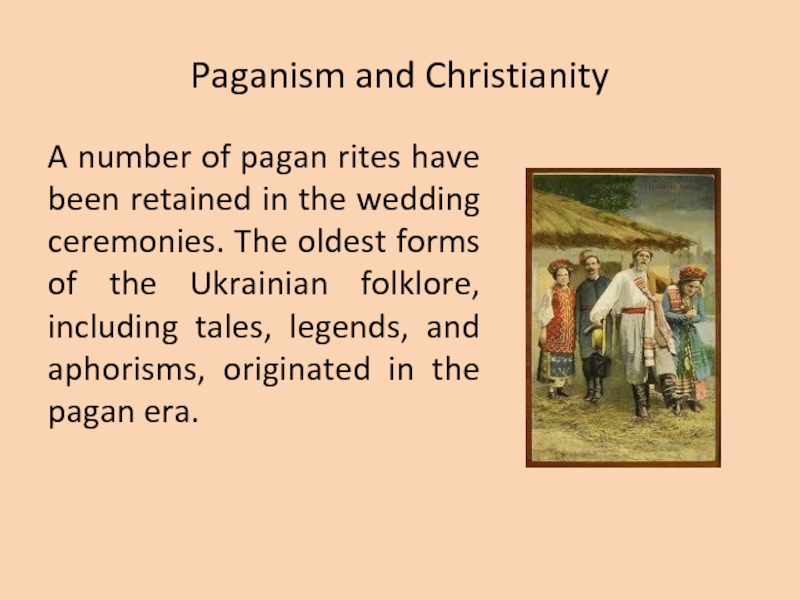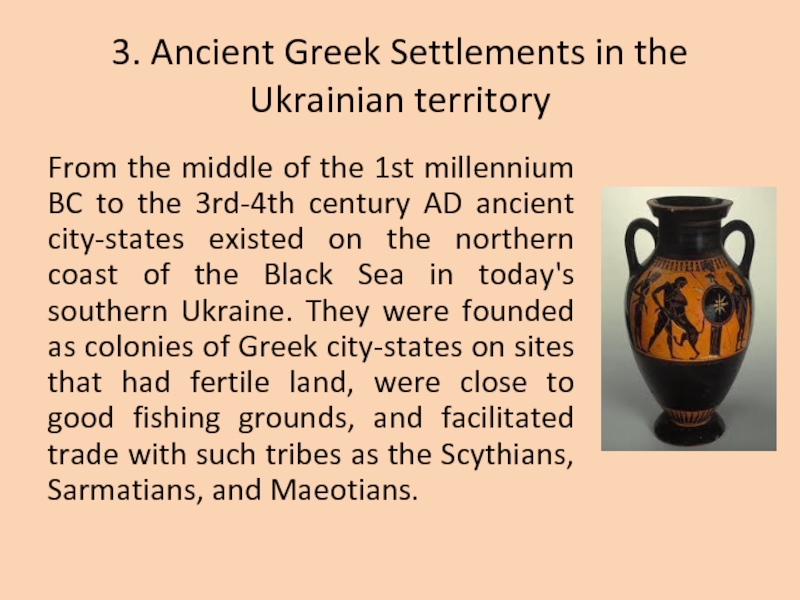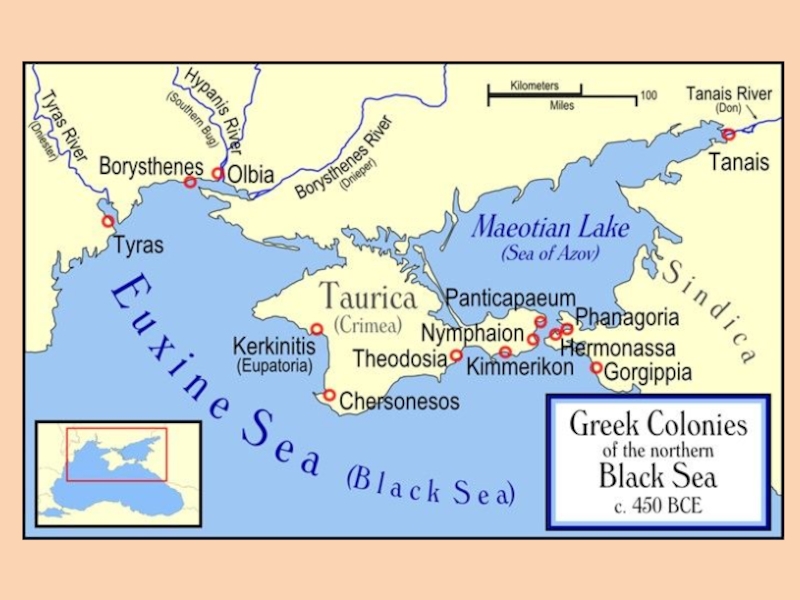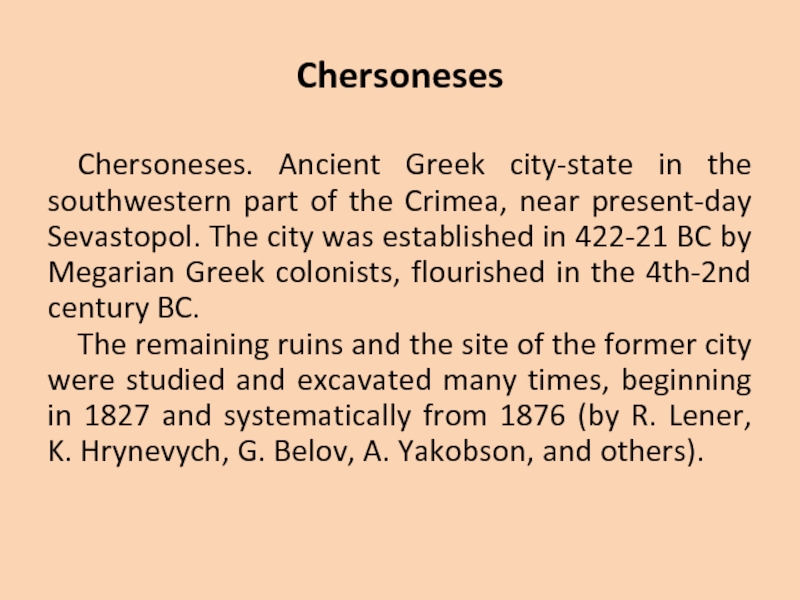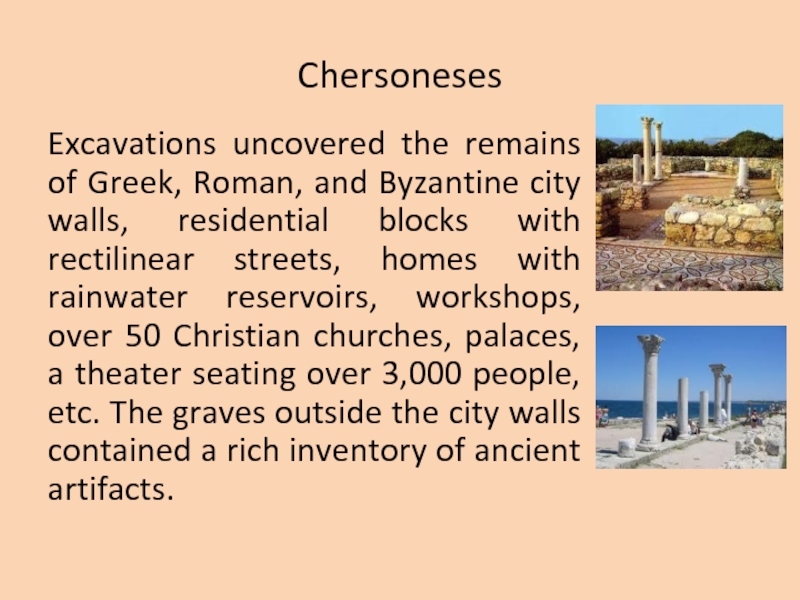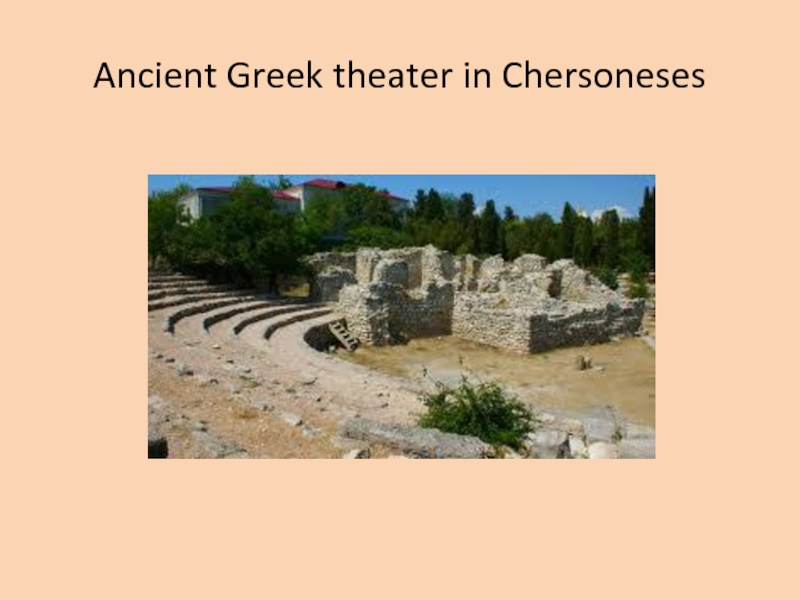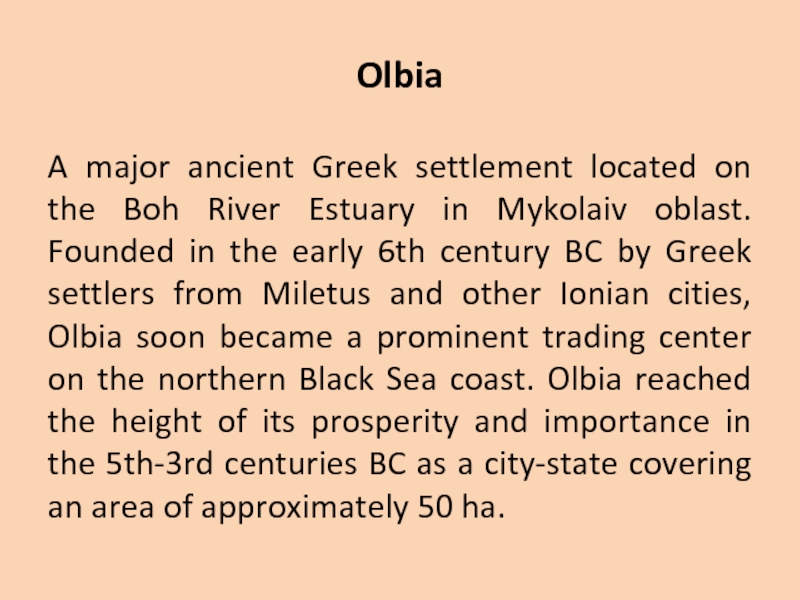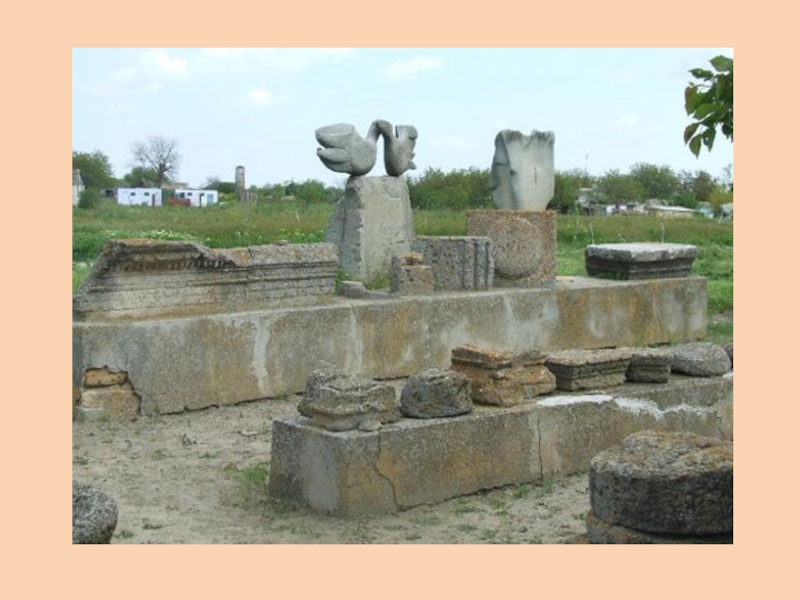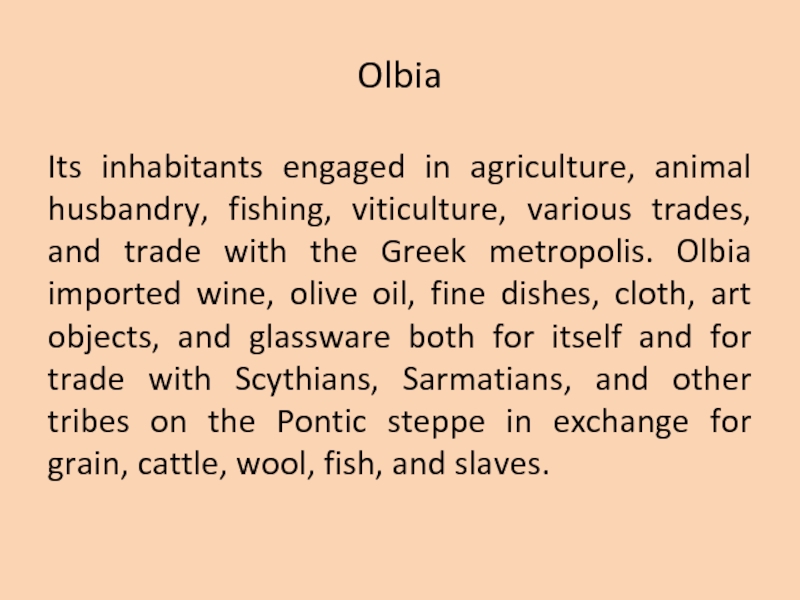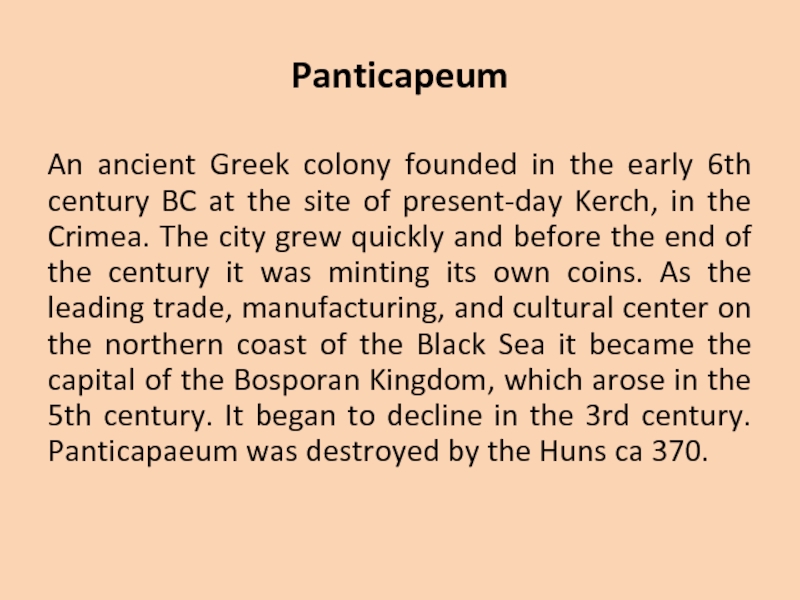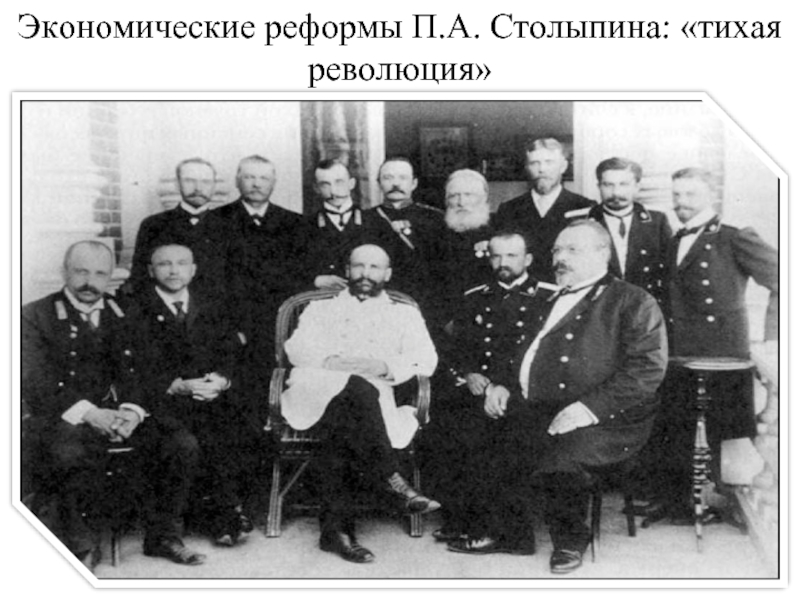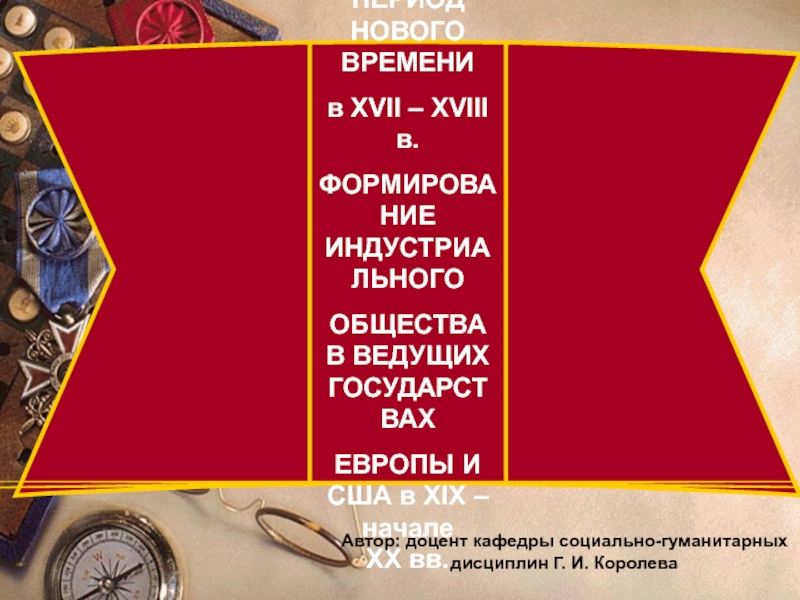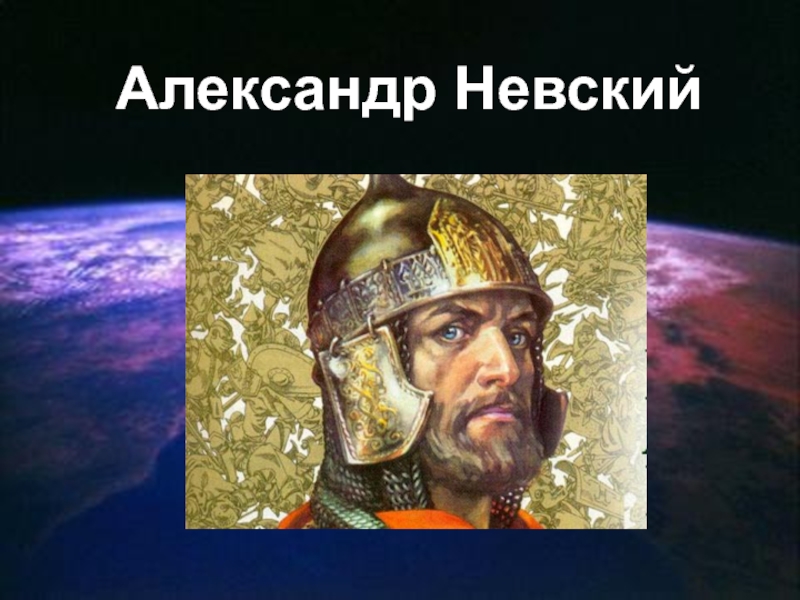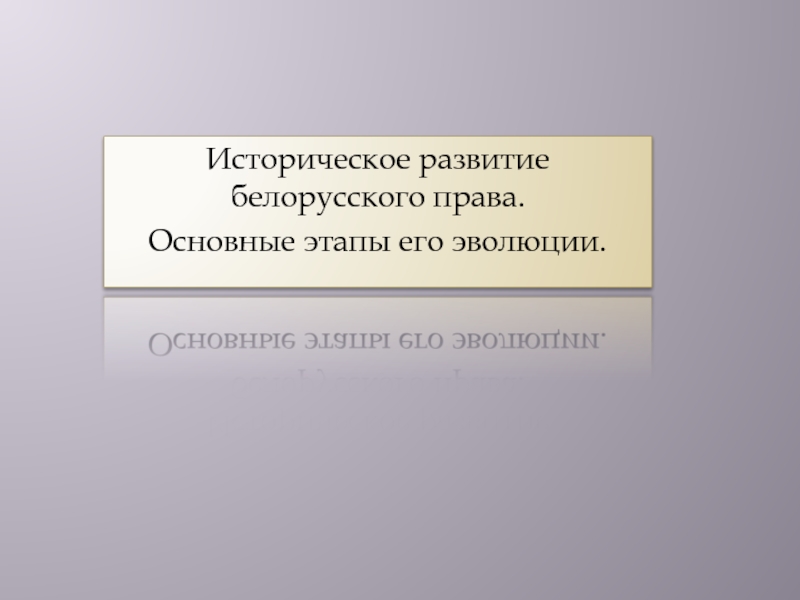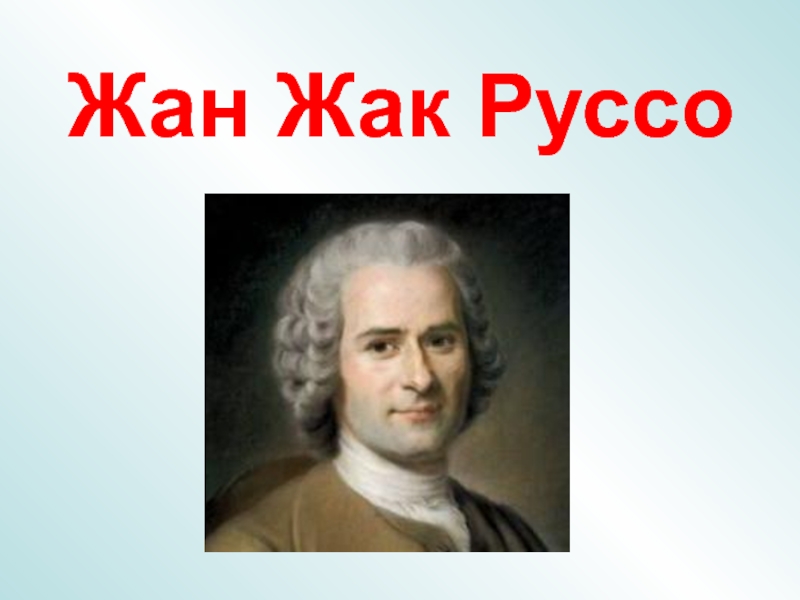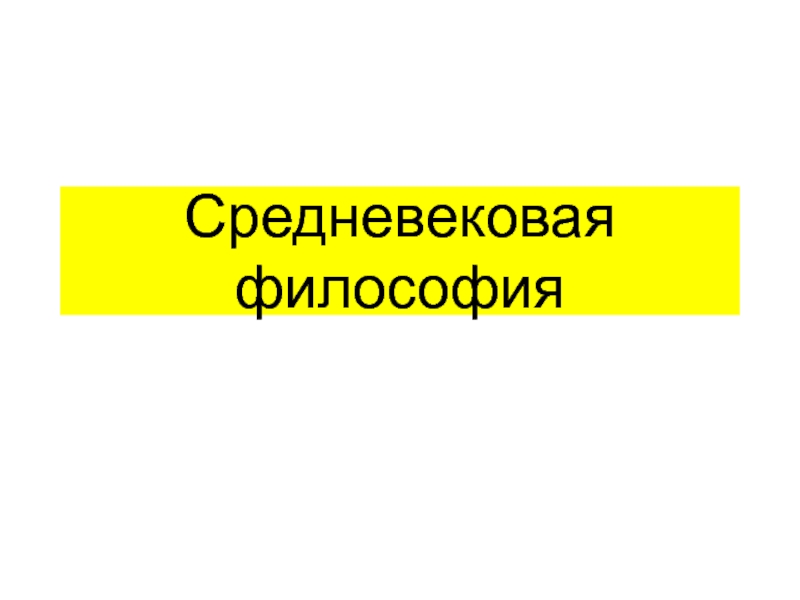Greek Settlements in the Ukrainian territory.
- Главная
- Разное
- Дизайн
- Бизнес и предпринимательство
- Аналитика
- Образование
- Развлечения
- Красота и здоровье
- Финансы
- Государство
- Путешествия
- Спорт
- Недвижимость
- Армия
- Графика
- Культурология
- Еда и кулинария
- Лингвистика
- Английский язык
- Астрономия
- Алгебра
- Биология
- География
- Детские презентации
- Информатика
- История
- Литература
- Маркетинг
- Математика
- Медицина
- Менеджмент
- Музыка
- МХК
- Немецкий язык
- ОБЖ
- Обществознание
- Окружающий мир
- Педагогика
- Русский язык
- Технология
- Физика
- Философия
- Химия
- Шаблоны, картинки для презентаций
- Экология
- Экономика
- Юриспруденция
Pre-christian culture презентация
Содержание
- 1. Pre-christian culture
- 2. 1. The Slavs The Slavs, the largest
- 4. The Slavs under name of the
- 5. Slavic religion The Slavs were pagans; their
- 6. There are primarily three sources of information about Slavic paganism:
- 7. The Earliest Slavic Religious Beliefs It is
- 8. The main constituent parts of early Slav’s religion were:
- 9. The Magic The
- 10. Animism The belief, common among primitive
- 11. Animism In ancient Slav’s believes animism is
- 12. Veneration of the dead The belief
- 13. Veneration of the dead As a display
- 14. Veneration of the dead Veneration of the
- 15. Totemism The belief that
- 16. Totemism Such personages of ancient Slav’s mythology
- 17. Polytheism The belief in a plurality of
- 18. Perun The supreme god of the East
- 19. Until the end of the 10th cent. an idol of Perun existed in Kiev
- 20. Svarog Svarog, a god known to most
- 21. Svarog’s sons Among his sons were Dazhbog,
- 22. Bilobog and Chornobog Two important gods of
- 23. Veles Veles was worshipped in two aspects:
- 24. Mokosh The goddess who both gives and
- 25. Zemlya-maty Various myths and ritualistic data, however,
- 26. 2. Traces of paganism in Christian festivals
- 27. Perun Saint Eliah
- 28. Veles Saint George
- 29. Kupajlo Saint Ioann the Baptist
- 30. The seasonal agricultural festivals were also modified and associated with Christian holidays:
- 31. The winter equinox became Christmas
- 32. The ‘Great Day’ (Velykden’) became Easter
- 33. The Rusaliji became the Descent of the Holy Spirit
- 34. Paganism and Christianity Each of these festivals
- 35. Paganism and Christianity The expected result, however,
- 36. Paganism and Christianity Traces of paganism were
- 37. Paganism and Christianity A number of pagan
- 38. 3. Ancient Greek Settlements in the Ukrainian
- 40. The Greek city-states The other colonies were
- 41. Chersoneses Chersoneses. Ancient Greek city-state in the
- 42. Chersoneses Excavations uncovered the remains of Greek,
- 43. Ancient Greek theater in Chersoneses
- 44. Olbia A major ancient Greek settlement located
- 46. Olbia Its inhabitants engaged in agriculture, animal
- 48. Panticapeum An ancient Greek colony founded in
Слайд 1Pre-Christian culture
Ancient Slavic Religion and Mythology.
Traces of paganism in Christian festivals.
Ancient
Слайд 21. The Slavs
The Slavs, the largest ethnic and linguistic group of
peoples in Europe belonging to the Indo-European linguistic family. It is estimated that the Slavs number over 300 million in the world.
Слайд 4
The Slavs under name of the Antes and the Sclaveni make
their first appearance in Byzantine records in the early 6th century.
The Slavs were probably dominated in succession by the Scythians and the Sarmatians
Слайд 5Slavic religion
The Slavs were pagans; their supreme god was the god
of lightning.
Due to the concerted efforts of both the eastern and western churches, Christianity largely replaced Slavic paganism during the course of the 9th and 10th centuries.
Due to the concerted efforts of both the eastern and western churches, Christianity largely replaced Slavic paganism during the course of the 9th and 10th centuries.
The term paganism (with its synonym ‘heathenism’) is used for any religion where several gods and goddesses are worshipped.
Слайд 7The Earliest Slavic Religious Beliefs
It is generally thought that the earliest
Slavic religious beliefs were based on the principle that the whole natural world is inhabited and directed by spirits or mysterious forces.
Слайд 9The Magic
The practice of manipulating and controlling the course of
nature by preternatural means. Magic is based upon the belief that the universe is populated by unseen forces or spirits that permeate all things.
Слайд 10Animism
The belief, common among primitive peoples, that all things in the
world (including stones, plants, the wind, rivers etc.) are imbued with some kind of spiritual or psychological presence; this may imply that things are 'ensouled' or 'animated' by a universal 'world soul‘.
Слайд 11Animism
In ancient Slav’s believes animism is represented by such mythical creatures
as mavka (the spirit of a tree), lisovyk (the forest’s spirit), vodyanyk and bolotyanyk (the spirits of rivers and swamps), domovyk (domestic spirit) etc.
Слайд 12Veneration of the dead
The belief that the deceased, often family members,
have a continued existence and/or possess the ability to influence the fortune of the living.
Слайд 13Veneration of the dead
As a display of veneration of the dead,
the early Slavs often buried their ancestors under thresholds (to they can protect alive family members from evil aliens).
Слайд 14Veneration of the dead
Veneration of the dead is represented by such
mythical personages as Baba Yaha, Koshchij (the immortal), rusalka (mermaid), upyr (vampire) etc.
Слайд 15Totemism
The belief that people are descended from animals, plants, and other
natural objects. Symbols of these natural ancestors, known as totems, are often associated with clans (groups of families tracing common descent).
Слайд 16Totemism
Such personages of ancient Slav’s mythology as vovkulaka, divchyna-kalyna, chuhajster can
be considered as elements of totemism.
Слайд 17Polytheism
The belief in a plurality of gods (usually assembled into a
pantheon) in which each deity is distinguished by special functions.
Слайд 18Perun
The supreme god of the East and South Slavs polytheistic pantheon
was Perun, god of lightning and thunder. Because he controlled the elements of nature, his aid and protection were strongly evoked at seed time and harvest.
Слайд 20Svarog
Svarog, a god known to most Slavic peoples, was regarded as
the father of the chief deities.
Слайд 22Bilobog and Chornobog
Two important gods of Slavic religion were Bilobog and
Chornobog. These two, who represented the opposing forces of good and evil, reflected the Slavic belief in the dualistic nature of the universe.
Слайд 23Veles
Veles was worshipped in two aspects: 1) he is god of
death and the underworld, god of music, and a sorcerer; 2) he is god of cattle wealth and commerce.
Слайд 24Mokosh
The goddess who both gives and takes life, the spinner of
the thread of life, the giver of the water of life.
Слайд 25Zemlya-maty
Various myths and ritualistic data, however, reveal the cults of many
other gods and lesser divinities, including the worship of earth goddess – Zemlya-maty (Mother the Earth).
Слайд 262. Traces of paganism in Christian festivals
Kievan Rus was christened
in 988 by Volodymyr the Great. The Christian church actively opposed paganism. It supplanted the more popular cults with Christian ones:
Слайд 30
The seasonal agricultural festivals were also modified and associated with Christian
holidays:
Слайд 34Paganism and Christianity
Each of these festivals retains to this day elements
of pagan rites. Gradually the church introduced its sacraments into everyday life – first into baptism and burial, then, finally, into marriage. Some pagan folk customs (caroling, the blessing of wells and fields) that could not be suppressed were simply adopted by the church.
Слайд 35Paganism and Christianity
The expected result, however, was not always achieved: in
most cases, Christian and pagan rituals with the same function were practiced side by side. Other pagan customs, such as the harvest rituals, were converted from religious into folkloric practices.
Слайд 36Paganism and Christianity
Traces of paganism were preserved longest in various seasonal
folk customs and rites, such as the Christian Eve dinner, carols, the Easter vesnyanky, the transfer of livestock to the pasture in the springtime, the Kupajlo Festival, the harvest rituals, and pomynky.
Слайд 37Paganism and Christianity
A number of pagan rites have been retained in
the wedding ceremonies. The oldest forms of the Ukrainian folklore, including tales, legends, and aphorisms, originated in the pagan era.
Слайд 383. Ancient Greek Settlements in the Ukrainian territory
From the middle of
the 1st millennium BC to the 3rd-4th century AD ancient city-states existed on the northern coast of the Black Sea in today's southern Ukraine. They were founded as colonies of Greek city-states on sites that had fertile land, were close to good fishing grounds, and facilitated trade with such tribes as the Scythians, Sarmatians, and Maeotians.
Слайд 40The Greek city-states
The other colonies were founded mostly in the 6th
century BC: Chersoneses (near Sevastopol), Olbia (on the Dnieper-Boh Estuary), and, in the Crimea, Panticapaeum (now Kerch), Theodosia (now Feodosiоa), Tiritaka, Nympheum, and Kerkinitis (now Yevpatoriia).
Слайд 41Chersoneses
Chersoneses. Ancient Greek city-state in the southwestern part of the Crimea,
near present-day Sevastopol. The city was established in 422-21 BC by Megarian Greek colonists, flourished in the 4th-2nd century BC.
The remaining ruins and the site of the former city were studied and excavated many times, beginning in 1827 and systematically from 1876 (by R. Lener, K. Hrynevych, G. Belov, A. Yakobson, and others).
The remaining ruins and the site of the former city were studied and excavated many times, beginning in 1827 and systematically from 1876 (by R. Lener, K. Hrynevych, G. Belov, A. Yakobson, and others).
Слайд 42Chersoneses
Excavations uncovered the remains of Greek, Roman, and Byzantine city walls,
residential blocks with rectilinear streets, homes with rainwater reservoirs, workshops, over 50 Christian churches, palaces, a theater seating over 3,000 people, etc. The graves outside the city walls contained a rich inventory of ancient artifacts.
Слайд 44Olbia
A major ancient Greek settlement located on the Boh River Estuary
in Mykolaiv oblast. Founded in the early 6th century BC by Greek settlers from Miletus and other Ionian cities, Olbia soon became a prominent trading center on the northern Black Sea coast. Olbia reached the height of its prosperity and importance in the 5th-3rd centuries BC as a city-state covering an area of approximately 50 ha.
Слайд 46Olbia
Its inhabitants engaged in agriculture, animal husbandry, fishing, viticulture, various trades,
and trade with the Greek metropolis. Olbia imported wine, olive oil, fine dishes, cloth, art objects, and glassware both for itself and for trade with Scythians, Sarmatians, and other tribes on the Pontic steppe in exchange for grain, cattle, wool, fish, and slaves.
Слайд 48Panticapeum
An ancient Greek colony founded in the early 6th century BC
at the site of present-day Kerch, in the Crimea. The city grew quickly and before the end of the century it was minting its own coins. As the leading trade, manufacturing, and cultural center on the northern coast of the Black Sea it became the capital of the Bosporan Kingdom, which arose in the 5th century. It began to decline in the 3rd century. Panticapaeum was destroyed by the Huns ca 370.
